Plant Sales Live on JuliaRedman.com
Creatures from the Black Lagoon!!! Yeah, maybe not, but just as rarely seen by the average human. What you are seeing here are orchid seeds just beginning to germinate. They are Laelia tenebrosa 'Coast Ovelins' AM/AOS x self, OSP stock# 1071, 12 days post sowing (FAST!). Orchid seeds are tiny, dust like things (see also this post), so images were taken using ~30x magnification (if I remember the lens magnification correctly) on a dissecting 'scope. The first really obvious sign of orchid germination is the presence of tiny little green balls of undifferentiated tissue. From this the first leaf and first root arise. But before any of that, if you have a sharp eye you'll notice the seeds get "fat" and more noticeable on the plate. This is the stage you are viewing now. The seeds with the opaque mass in the center are the ones that are growing. The ones that are thin and transparent are not growing. These may germinate at a later date, but more likely they will not germinate at all. The extra fat one is a little further along. In another week or two it should be obviously green and enlarged. The image above was taken with 'normal' light. The one below was taken using blue light and a red/green filter. With this setup, you can see the presence of active chlorophyll under this setup as evidenced by the red color of the fattest seed. Chlorophyll pigments naturally fluoresce red under blue light.
Yeah, maybe not, but just as rarely seen by the average human. What you are seeing here are orchid seeds just beginning to germinate. They are Laelia tenebrosa 'Coast Ovelins' AM/AOS x self, OSP stock# 1071, 12 days post sowing (FAST!). Orchid seeds are tiny, dust like things (see also this post), so images were taken using ~30x magnification (if I remember the lens magnification correctly) on a dissecting 'scope. The first really obvious sign of orchid germination is the presence of tiny little green balls of undifferentiated tissue. From this the first leaf and first root arise. But before any of that, if you have a sharp eye you'll notice the seeds get "fat" and more noticeable on the plate. This is the stage you are viewing now. The seeds with the opaque mass in the center are the ones that are growing. The ones that are thin and transparent are not growing. These may germinate at a later date, but more likely they will not germinate at all. The extra fat one is a little further along. In another week or two it should be obviously green and enlarged. The image above was taken with 'normal' light. The one below was taken using blue light and a red/green filter. With this setup, you can see the presence of active chlorophyll under this setup as evidenced by the red color of the fattest seed. Chlorophyll pigments naturally fluoresce red under blue light. They're alive!!! Eek! :)
They're alive!!! Eek! :)
Hey plant fans! I'm still up, should be sleeping. (details!...) But I do have a lovely Clivia xCrytanthiflora to show you. This is a natural hybrid clivia between the two speices miniata and nobilis. I must say, I'm quite partial to the tube shaped clivia flowers. I've had this plant for a little over a year. It gets pretty low light (as in, equivalent to what an African violet might enjoy), and rather infrequent waterings as I grow stuff on the somewhat dry side. It is in a large clay pot with a media consisting of a high percentage of coir fiber, my preferred component for Clivia plants.
But I do have a lovely Clivia xCrytanthiflora to show you. This is a natural hybrid clivia between the two speices miniata and nobilis. I must say, I'm quite partial to the tube shaped clivia flowers. I've had this plant for a little over a year. It gets pretty low light (as in, equivalent to what an African violet might enjoy), and rather infrequent waterings as I grow stuff on the somewhat dry side. It is in a large clay pot with a media consisting of a high percentage of coir fiber, my preferred component for Clivia plants. Also happening this weekend is the first of the Phal. (San Luca x Minstral's Pixie Prelude) plants finally opened a flower. They say "A watched pot never boils." Similarly, a watched orchid takes FOREVER to bloom. ::shakes fist:: I'd say my first impression is its quite a nice hybrid though. Those in spike have nice, stout spikes with fat buds. I don't know yet if they'll all follow this one with crystalline white background and a fine purple-pink netting overlay, but I suspect they will be similar. Great young plants!
Also happening this weekend is the first of the Phal. (San Luca x Minstral's Pixie Prelude) plants finally opened a flower. They say "A watched pot never boils." Similarly, a watched orchid takes FOREVER to bloom. ::shakes fist:: I'd say my first impression is its quite a nice hybrid though. Those in spike have nice, stout spikes with fat buds. I don't know yet if they'll all follow this one with crystalline white background and a fine purple-pink netting overlay, but I suspect they will be similar. Great young plants!
Saturday marked the 29th Annual Paph Forum in DC, and what follows is a selection of photos from the well attended show table. At the time I was taking my last photos, though, a number of plants had already been removed for judging, so the table shots are not as filled out as they would have been first thing in the morning.The left side of the auditorium was mainly populated by complex hybrids sorted according to color/markings, or teacup and novelty groups.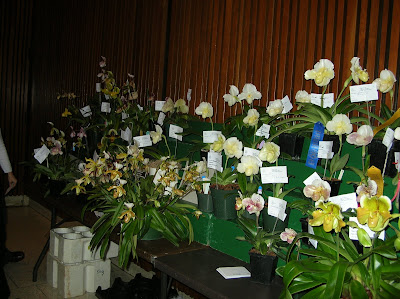
 The right side of the room contained the Phragmipediums, and Paph species and other hybrid types (maudiae, multifloral, etc.).
The right side of the room contained the Phragmipediums, and Paph species and other hybrid types (maudiae, multifloral, etc.).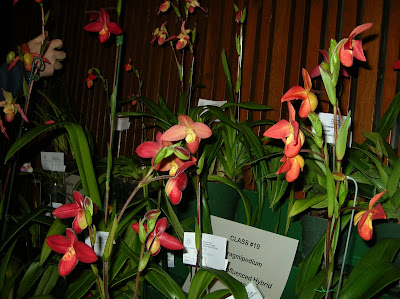
 Paph. hookerae
Paph. hookerae Paph. bellatulum
Paph. bellatulum An alba Paph. philippinense
An alba Paph. philippinense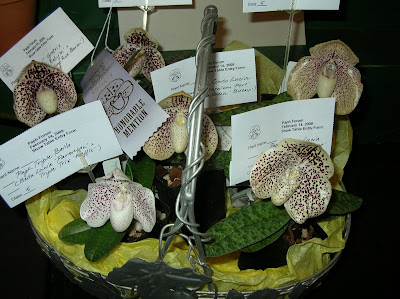 A basket of brachy hybrids
A basket of brachy hybrids And a contestant from the "Ugly Slipper" class. Clone names in this group were fantastic.
And a contestant from the "Ugly Slipper" class. Clone names in this group were fantastic.
We were also treated to four talks and many lovely photos. The last of the speakers was John of Parkside Orchids. He gave a very interesting talk about what impact the pot plant market has on the hobby market. If the majority of sales worldwide of orchids are in the pot plant market, this then is what supports the business of the large breeding houses. This has different production rules and goals than the hobby market - fast production of strong and uniform plants that will appeal to a customer with a somewhat different set of requirements than an average plant geek. That isn't to say that the pot plant market does not produce good plants, because they in fact do. But the needs of this market largely dictate what the large breeding houses do with their time. For example, fewer phrags are produced by production breeding now because they can't sell enough of them fast enough to make production worthwhile. This is why we see fewer Phrags on the market today than a few years back. Food for thought.
 To close, two photos of a nicely variegated Paph. insigne. Now that is a rarity!
To close, two photos of a nicely variegated Paph. insigne. Now that is a rarity!
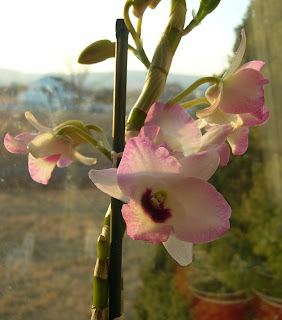
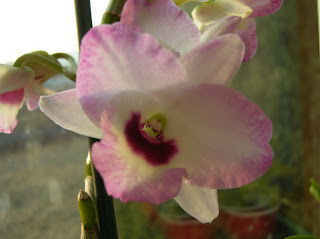 That's right, yet another 'in bloom'. :)This time it is a first bloom Dendrobium (Himezakura x Super Ise) seedling. Recently I've been having a mild love affair with dendrobium species, so I just decided it was time to give the Nobile's a shot. For a very long time now I have coveted noblie type dendrobiums, but somehow got it into my head that they were hard to grow. They really aren't (see below for culture information). I bought a batch of these Himezakura x Super Ise seedlings almost a year ago and they've been doing quite nicely so far. This is the first of the seedlings to bloom, but a few of the others also have buds starting. Very exciting - maybe we'll get to see a few more soon if they don't get bought up (they're listed in my shop, in bud goes first!).
That's right, yet another 'in bloom'. :)This time it is a first bloom Dendrobium (Himezakura x Super Ise) seedling. Recently I've been having a mild love affair with dendrobium species, so I just decided it was time to give the Nobile's a shot. For a very long time now I have coveted noblie type dendrobiums, but somehow got it into my head that they were hard to grow. They really aren't (see below for culture information). I bought a batch of these Himezakura x Super Ise seedlings almost a year ago and they've been doing quite nicely so far. This is the first of the seedlings to bloom, but a few of the others also have buds starting. Very exciting - maybe we'll get to see a few more soon if they don't get bought up (they're listed in my shop, in bud goes first!).
Growing Nobile hybrids:
These are dwarf nobile type, reaching perhaps a height of ~18 inches (currently ~10 inches tall in 2.5 inch pots). Nobile group plants are deciduous, meaning they generally shed their leaves every year. Don't worry when the leaves start looking a little blah in winter than fall off as long as the canes look good.
Grow like a phalaenopsis in summer for light, temperature, and water, but decrease temperature somewhat in winter. If they don't flower for you they're not cool enough at night - especially if they make keikis instead of flowers. I keep my plants on a screened porch in summer, leaving them out in the fall until it is quite chilly at night (perhaps 50F at night), then put them in my unheated basement under artificial light. Some of them had already started to initiate buds when they came in for winter. They would also be great for rooms with drafty windows or little to no heat in winter. You'd be surprised how much cooler it is in your bay window than your house in the winter.
I also increase light in winter in accordance with recommendations from other growers, but given that they drop their leaves I'm not convinced that even matters. Also be aware that cooler temperatures in winter means a less frequent need for watering.
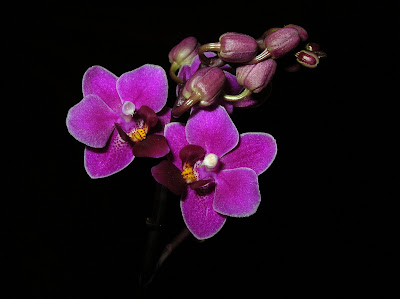 Ahh...I think we can officially declare phalaenopsis blooming season "open". While I have a couple plants in bloom most any time of the year, February through April is usually the peak season. There's stuff in bud just everywhere and new flowers opening every day. I just love spring!Today I have a classic miniature to show you - Phal. Zuma's Pixie. This is the clone 'Taida'. The cross is one of the greats of miniature or sweetheart phalaenopsis breeding. Bred out of Carmela's Pixie and equestris, it has masses of ~1 inch flowers, usually on branched spikes, all on a compact plant. This is a youngster, but even this one has a little branch on its spike (but you can't really see it in the photo).
Ahh...I think we can officially declare phalaenopsis blooming season "open". While I have a couple plants in bloom most any time of the year, February through April is usually the peak season. There's stuff in bud just everywhere and new flowers opening every day. I just love spring!Today I have a classic miniature to show you - Phal. Zuma's Pixie. This is the clone 'Taida'. The cross is one of the greats of miniature or sweetheart phalaenopsis breeding. Bred out of Carmela's Pixie and equestris, it has masses of ~1 inch flowers, usually on branched spikes, all on a compact plant. This is a youngster, but even this one has a little branch on its spike (but you can't really see it in the photo).
 I think Phalaenopsis amabilis (aka rimestadiana) is an under-appreciated species. I assume it is overlooked due to its similarity to the over produced "big white phalaenopsis". My plant is a compact, stout growing plant with lovely, shiny, and thick leaves and strong roots. The species produces a strong inflorescence with tiled flowers, and on occasion you might find a plant with fragrant flowers.The species is easy to grow either mounted or potted. It is adaptable to a wide range of light conditions and therefore an excellent houseplant, appropriate for all levels of orchid growers.
I think Phalaenopsis amabilis (aka rimestadiana) is an under-appreciated species. I assume it is overlooked due to its similarity to the over produced "big white phalaenopsis". My plant is a compact, stout growing plant with lovely, shiny, and thick leaves and strong roots. The species produces a strong inflorescence with tiled flowers, and on occasion you might find a plant with fragrant flowers.The species is easy to grow either mounted or potted. It is adaptable to a wide range of light conditions and therefore an excellent houseplant, appropriate for all levels of orchid growers.


